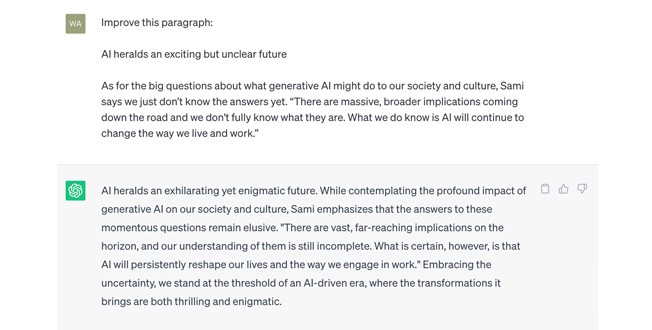Please visit the updated page here: Generative AI: what’s in it for me?
Generative AI: what’s in it for me?

When ChatGPT registered 100 million monthly active users in January 2023, only two months after launch, it became the fastest growing consumer application in history. Its success prompted months of discourse on the potential for generative artificial intelligence to reshape society.
To help better understand the significance of this transformative technology, we invited Sami Makelainen, Research Affiliate at the Institute for the Future, and AI expert to speak at Telstra Wholesale Business Connect 23 on what the future of AI might hold for businesses.
The arrival of generative AI
“We already swim in an ocean of AI,” Sami says. “Our smartphones are imbued with AI: Siri, or Google assistant only work because of AI. Our photos app only works because of AI. If we use a content platform, we are exposed to AI recommendation engines many, many times a day.”
It’s a measure of the technology’s success, and its integration into our daily lives, that we don’t spend a lot of time thinking about these use cases as artificial intelligence. Generative AI is different because it is novel, consumers are adopting it at a rapid pace, and because of what it can do.
So what exactly is generative AI?
Generative AI is a type of artificial intelligence system capable of generating text, images, or other media in response to prompts. Generative AI models learn the patterns and structure of their input training data, and then generate new data that has similar characteristics.
“From a technical point of view, there is no one thing or one technology called generative AI,” Sami says. “It's just terminology to describe a particular use case for a number of different AI models.”
Such generative AI models include latent division models as used by the image generator Midjourney and large language models (LLMs) employed by ChatGPT.
The business use case
Generative AI has the potential to be applied in many areas of business.
“We've already seen examples of generative AI usefully employed in marketing and communications,” Sami says. “It’s an extremely fast and cheap way of visualising ideas or creating draft copy as a starting point.”
One of the other main use cases currently is conversational guidance for customer support agents.
“The first empirical study of real world economic effects of these new AI systems was released by the National Bureau of Economic Research a few weeks ago,” Sami notes.
“The researchers looked at what happened to an unnamed Fortune 500 company after it introduced a version of ChatGPT for their customer support. The results were promising. On average, employees in the customer service domain were 14% more productive. Employee satisfaction rose and the customers were more satisfied as well."
These results sound like AI is a win-win for all concerned. However, there are several genuine concerns about the impact on jobs, cyber security, and the reliability, trustworthiness, ownership and provenance of the data produced by AI models.
Should your business invest in building AI capabilities?
As with any novel technology, one of the big questions is how should a business use it, and when? And do the answers to those questions mean businesses should invest in their own AI capabilities?
“There are so many use cases for generative AI for organisations and individuals alike that it can be hard to know where to start,” Sami cautions. “For most organisations at this stage where not to start is hiring a group of AI engineers. The capabilities are increasing and improving at an incredibly rapid pace. The current state-of-the-art generated AI models require a lot of data and training costs are high, so it's unlikely you can beat the leaders.”
However, Sami says there are three steps businesses can take now to get them in a good position to navigate the complexities of mass adoption of generative AI.
Three steps businesses can take now.
Prepare
First, prepare your organisation for the arrival of generative AI. “Start by discussing the opportunities and challenges as your organisation sees them,” Sami advises. “Put a governance structure in place, with ethics guidelines, and tools and support for experimentation.”
Experiment
Second, play with it in a safe way. “Use the structures and guidelines you put in place to let your people loose in a safe sandbox environment. Let them experiment. Let them find what works for your organisation, but do it in a controlled way.”
Adopting the opposite approach, with a zero tolerance clamp down on AI use may increase your security risks, rather than reduce them, as Sami explains. “Banning everything is possibly the most dangerous approach because your people will use it anyway, but they won’t tell you.”
Implement programs thoughtfully.
The way AI programs are implemented will be critical to achieving buy-in and effectiveness. Humans will continue to play a critical role. “We want to avoid situations where a human is no longer in control of what they're doing, but they are being held accountable,” says Sami. “Overcoming that challenge requires a mindful approach to adopting this technology. For example, we should ask ourselves: when does efficiency end as a value for us? AI is a means of becoming more efficient. But how far do we want to take that?”
AI heralds an exciting but unclear future
As for the big questions about what generative AI might do to our society and culture, Sami says we just don’t know the answers yet. “There are massive, broader implications coming down the road and we don't fully know what they are. What we do know is AI will continue to change the way we live and work.”
This article was written by a human without the assistance of generative AI!
But here’s an example of how chat GPT could currently rewrite the last paragraph:
